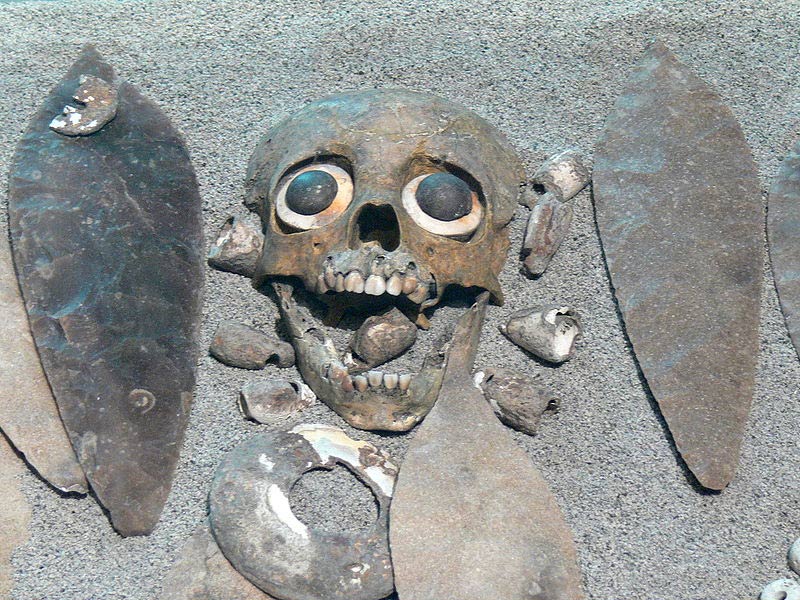Bizarre Rituals of Blood and Death That Are Rooted in the Ancient World
Throughout history, there are many rituals that individuals and groups participate in which could be considered strange or unusual by others. The following is a short overview of some of the uncanny rituals that have their roots in the ancient world. Some of these unconventional practices have survived up to the present day.
Aghori and Incense in India
In India, the Aghori are ascetic Shaiva sadhus (holy men) known to engage in post-mortem rituals. They dwell in charnel grounds, smear cremation ashes on their bodies, and they use human bones to create jewelry and human skulls to make kapalas - ritual skull cups.
Their practices are contradictory to orthodox Hinduism, so most of their acts are also opposed to by other Hindus. The Aghori meditate and worship in sites others may call “haunted houses.” Aghori gurus do command great reverence from rural populations, however, as they are believed to have healing powers obtained through their intense rites and practices of renunciation. The Aghori were featured in the movie “The Other Side of the Door” from 2016.

Aghori Contemplating... (CC BY-ND 2.0)
Another strange ritual preserved since ancient times also takes place in India. On a certain day of the year, believers go to the temple where they inhale a specific type of incense which is burned by the priests. This results in a trance like state.
After this, the believers are led to the village cemetery by the priests. There, they dig out the deceased bodies of their relatives and begin to chew on them. The explanation behind this act is that with each bite, the soul of the deceased gains more peace and welfare in the afterlife. Once the ritual is completed, the believers bury the corpses again and leave the cemetery…only to return for the same ritual in the next year.
- Forgotten Rituals and Magical Practices in Ancient History
- Bizarre 12,000-Year-Old Burial Rituals of Shaman Woman Revealed
- Foundation Rituals of Ancient Egypt: Elaborate Rites Conducted to Protect Great Monuments
Japanese Self-Mummification
Another peculiar ritual is self-mummification. This practice was outlawed in Japan in the 20th century. The act was related to a Buddhist belief in separating themselves from the world. Some monks, however, took this idea to the extreme by dieting until they died. By preserving their bodies, the monks would demonstrate their holiness.
Usually, the ritual started with a three-year diet of seeds and nuts. This was complemented by a series of physical exercises meant to get rid of all the body fat. For the next three years, the diet would change to tree bark, roots, and a poisonous tea made from the Urushi tree. This tea made the monks vomit - thus losing bodily fluid and killing off any maggots that might move in after death.
Ultimately, the monk locked himself in a tomb in the lotus position. There, he had a breathing tube and a bell which he rang in order to signal to others that he was still alive. Once the monk died, the tomb was sealed up. Until the present day, about 20 self-mummified monks have been discovered.

A Buddhist Mummy. (CC BY-SA 3.0)
Yanomamo Death Consumption
The Yanomamo people of Venezuela have a ritual for eating their dead. This ceremony long predates their discovery by westerners. The Yanomamo are one of the few polygamous cultures left on the globe and they take hallucinogens when they feel sick. Still, their death rituals are what most people consider the oddest aspects of the tribe.
- From Magic to Science: The Intriguing Ritual and Powerful Work of Alchemy
- 5,000-year-old musical scene found on pottery in Israel may reflect sacred marriage ritual
- Purification as the Core of the Ancient Shinto Faith
Of course, this ritual is related to a belief as well. It is thought that the dead are taken by soul eaters with unquenchable hunger who consume their life force, and if the chain is not stopped they will continue to eat until the whole world dies. As a result, in order to stop the evil soul eaters, the Yanomamo eat their own dead. First, they cremate the body and then they grind up the biggest bones in a pestle and mortar. They use the result as the base for a plantain soup.

Cannibalism, Brazil. Engraving by Theodor de Bry to illustrate Hans Staden's account of his captivity in 1557. (Public Domain) The Yanomamo practice of eating their dead differs greatly from this perception of cannibalism.
Thookkam Festival
Thookkam is a festival in India in which people are pierced with hooks then hoisted onto a frame for a couple of hours. Even though it has ancient roots, the festival has just been banned by the Indian government. The event used to take place in South Kerala, in temples devoted to Kali. People dance and the blood is said to pacify Kali from going on a terrible rampage. The hooked believers were hung on a sort of scaffolding frame and carried three times around the temple. The spilled blood was then offered to Kali in order to appease her.
Video Showing the Festival of Thookkam
These are but a few rituals with ancient origins. Many were meant to appease the gods, but they also had other purposes which were often believed to help individuals or societies.
Top image: Aztec burial of a sacrificed child at Tlatelolco (public domain)
By Valda Roric
References:
Valda Roric – “Wonders of History and Mythology”
Valda Roric – “From History to Mystery”
Emily Teeter – “Religion and Ritual in Ancient Egypt”
K. C. Chang – “Art, Myth and Ritual: The Path to Political Authority in Ancient China”



















